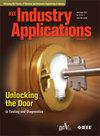Applications of Data-Driven Dynamic Modeling of Power Converters in Power Systems: An Overview
IF 4.2
2区 工程技术
Q2 ENGINEERING, ELECTRICAL & ELECTRONIC
引用次数: 0
Abstract
Power electronic converter (PEC)–based resources are growing ubiquitously in power systems and there is a vital necessity for precise dynamic models to comprehend their dynamics to different events and control strategies. Inaccurate modeling can lead to instability, higher costs, and reliability issues. Anticipating the increase in PECs in the near future, detailed modeling becomes computationally and mathematically complex, requiring extensive computing power and knowledge of vendor-specific PECs. To overcome these challenges, data-driven machine learning/artificial intelligence (ML/AI) approaches are widely used, tracking the dynamic responses of PECs operating in various modes with limited knowledge. These models find applications in protection, stability, fault diagnosis, optimization, control and monitoring, and power quality. While the literature on power systems often emphasizes the advantages of data-driven modeling, an in-depth look at the limitations, challenges, and opportunities related to converter-dominated grids is still lacking. The purpose of this survey is to conduct a comprehensive review of ML/AI methodologies in PECs and investigate their applications in power systems. The article introduces various PEC types, their roles, and modeling approaches. It then provides an in-depth overview of how ML/AI can be applied to PECs in power systems. Finally, the survey highlights gaps in the field's knowledge and suggests potential directions for future research.数据驱动的电力变换器动态建模在电力系统中的应用综述
基于电力电子变流器(PEC)的资源在电力系统中日益普及,因此亟需建立精确的动态模型,以了解其在不同事件和控制策略下的动态变化。不准确的建模会导致不稳定、成本上升和可靠性问题。预计在不久的将来,PEC 会越来越多,详细的建模在计算和数学上变得复杂,需要大量的计算能力和特定供应商 PEC 的知识。为了克服这些挑战,数据驱动的机器学习/人工智能(ML/AI)方法得到了广泛应用,可以在有限的知识范围内跟踪在各种模式下运行的 PEC 的动态响应。这些模型可应用于保护、稳定性、故障诊断、优化、控制和监测以及电能质量等领域。尽管有关电力系统的文献经常强调数据驱动建模的优势,但仍缺乏对变流器主导电网的局限性、挑战和机遇的深入研究。本调查旨在全面回顾 PEC 中的 ML/AI 方法,并研究其在电力系统中的应用。文章介绍了各种 PEC 类型、作用和建模方法。然后,文章深入概述了如何将 ML/AI 应用于电力系统中的 PEC。最后,调查强调了该领域的知识差距,并提出了未来研究的潜在方向。
本文章由计算机程序翻译,如有差异,请以英文原文为准。
求助全文
约1分钟内获得全文
求助全文
来源期刊

IEEE Transactions on Industry Applications
工程技术-工程:电子与电气
CiteScore
9.90
自引率
9.10%
发文量
747
审稿时长
3.3 months
期刊介绍:
The scope of the IEEE Transactions on Industry Applications includes all scope items of the IEEE Industry Applications Society, that is, the advancement of the theory and practice of electrical and electronic engineering in the development, design, manufacture, and application of electrical systems, apparatus, devices, and controls to the processes and equipment of industry and commerce; the promotion of safe, reliable, and economic installations; industry leadership in energy conservation and environmental, health, and safety issues; the creation of voluntary engineering standards and recommended practices; and the professional development of its membership.
 求助内容:
求助内容: 应助结果提醒方式:
应助结果提醒方式:


